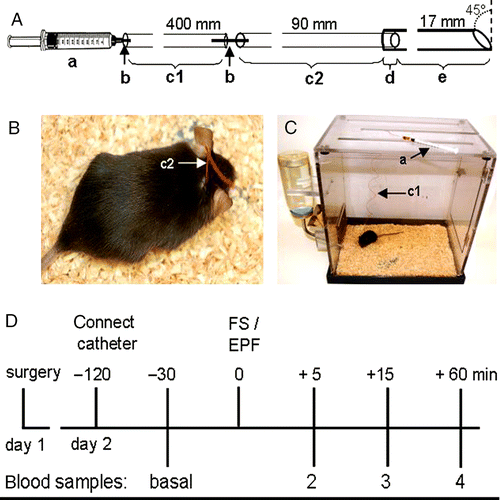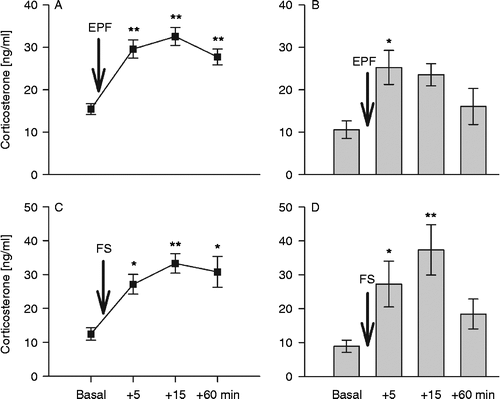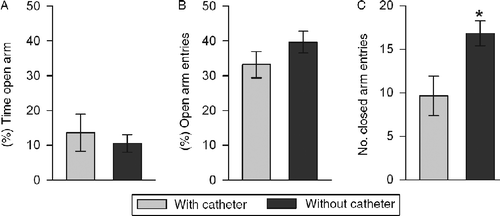Figures & data
Figure 1(a). Schematic representation of the mouse catheter system adapted for repeated blood sampling in conscious mice; a: 1-ml syringe, b: a 15-mm piece of a 27-G cannula, c1: a 400-mm PE-10 extension tubing (ID 0.28 mm; OD 0.61 mm) which is linked to the catheter through another 15-mm piece of 27-G cannula. The catheter is composed of a PE-10 tubing (c2: 90-mm long) connected through a 5-mm overlap (d) to a silicone tubing (e: ID 0.30 mm; OD 0.64 mm, 17-mm long), beveled at its tip to an angle of about 45°. (b). Mouse with already implanted catheter, exteriorized through the nape of the neck. (c). Representation of a catheterized mouse in the Plexiglas cage with the extended PE-10 connection tubing (arrow, c1) attached to the syringe (arrow, a) lying on top of the cage. (d). Schematic representation of the blood sampling protocol: about 24 h after surgery, the indwelling jugular vein catheter is connected to the PE-10 extension tubing and the 1-ml syringe 90 min before the start of the experiment. Thirty minutes after collection of the basal sample, the mouse is exposed for 5 min to the elevated platform (EPF) or (another group of mice) to 60 s of forced swim (FS). At 5, 15, and 60 min after termination of stressor exposure, blood samples 2, 3, and 4 are collected.

Figure 2. Corticosterone concentrations in mouse venous blood repeatedly collected through a chronically implanted indwelling jugular vein catheter immediately (post surgery; postS) and 24 h after surgery ((a): n = 6), 24 h after surgery under basal conditions at 15-min intervals with replacement of 100 μl sterile saline after each blood sampling ((b): n = 3); and 24 h after surgery under basal conditions as well as 5, 15, and 60 min after exposure to an elevated platform ((c): EPF, arrow, 5 min; n = 6). Data represent means ± SEM; **P < 0.01 versus basal.

Figure 3. Corticosterone concentrations in mouse blood collected through a chronically implanted indwelling jugular vein catheter ((a,c): n = 10) or from trunk blood ((b,d): n = 7–10) under basal conditions as well as 5, 15, and 60 min after stressor exposure (arrow): (a) and (b) show plasma corticosterone concentrations after exposure to the elevated platform (EPF, 5 min), (c) and (d) after exposure to forced swim (FS, 60 s). Data represent means ± SEM; **P < 0.01, *P < 0.05 versus basal.

Figure 4. Anxiety-related behavior of mice with (n = 8) and without (n = 11) a chronic jugular vein catheter 4 days after surgery represented by the percentage of: (a) time spent in the open arms of the elevated plus maze, and (b) entries performed into the open arms of the elevated plus maze. Closed arm entries (c) reflect locomotor activity. Data represent means ± SEM; *P < 0.05 versus catheter group.
